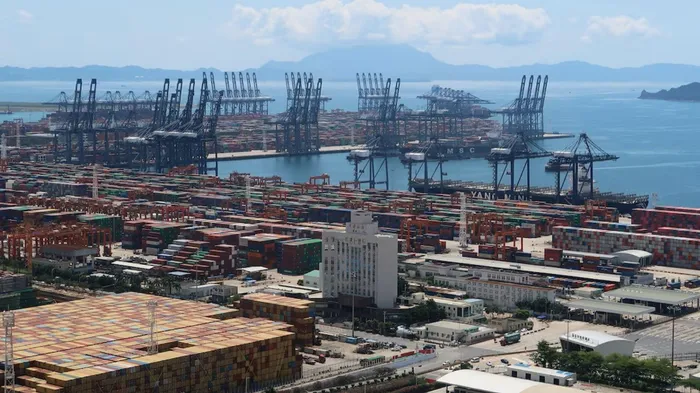Container losses at sea rise in 2024: What the World Shipping Council report reveals

The World Shipping Council (WSC) Container Lost at Sea 2025 report indicated that 576 containers were lost at sea in 2024, which is an increase from 221 containers lost in 2023 but remains well below the 10-year average of 1,274 containers lost annually.
Image: : Reuters, Martin Pollard
The World Shipping Council (WSC) Container Lost at Sea 2025 report indicated that 576 containers were lost at sea in 2024, which is an increase from 221 containers lost in 2023 but remains well below the 10-year average of 1,274 containers lost annually. The report also indicated that 200 containers were lost around the region of the Cape of Good Hope in South Africa. A master mariner believes that even a small loss of containers is a concern for shipping lines.
The report said that the figures underscore continued industry progress on safety and prevention. “Container losses in 2024 were influenced by ongoing disruption in the Red Sea region, which led to a significant shift in global trade routes. Vessel transits around the Cape of Good Hope increased by 191% compared to 2023.”
The report added that this area is well-known for hazardous maritime conditions, which contributed to a concentration of losses. “The South African Maritime Safety Authority says around 200 containers were lost in this region alone. Despite these challenges, the proportion of containers lost relative to those transported remains exceptionally low - just 0.0002 percent of the approximately 250 million containers transported globally in 2024.”
Joe Kramek, President and CEO of the World Shipping Council, said that this year’s report confirms that the vast majority of containers are transported safely across the oceans. “Still, even one container lost is one too many. Despite continued loss-prevention efforts by the industry, the re-routing of transits away from the Red Sea and around the Cape of Good Hope to keep global commerce moving has ocean carriers navigating one of the world’s most challenging routes.”
The report said that there are continued efforts across the liner shipping industry to improve container handling, stowage, and securing practices. “Safety is a shared responsibility, and the report outlines the critical roles played by each part of the supply chain—from shippers and freight forwarders to terminal operators and ocean carriers.”
Malcolm Hartwell, Norton Rose Fulbright director and master mariner, said that the loss of 576 containers is a tiny percentage of the 250 million containers transported annually by sea. “Compulsory reporting of container losses is not yet in effect, so the numbers may be higher than reported. The losses, even if reduced over the last few years, are an ongoing concern to the shipping lines, WSC and regulators. While most containers sink or are washed ashore quite soon after falling into the sea, they do remain a navigational hazard to yachts and smaller ships and can pose a significant threat to the environment depending on their contents.”
Hartwell added that in the last several years, South Africa has had two incidents involving containers of nurdles, which are the small plastic pellets used in the manufacture of packaging, which resulted in clean-up costs running into millions of dollars. “The WSC and shipping lines have been involved for a number of years in investigating the root cause of losses and taking steps to minimize them, which efforts have contributed to the decline in the last few years. The increase this year is attributed in part to the virtual closure of the Red Sea, which has seen a 191% increase in traffic around the South African coast where it was reported that 200 containers were lost last year.”
Hartwell said that ships that were planning for the relatively benign weather conditions they would experience passing through the Suez Canal and Mediterranean have had to contend with the aptly named Cape of Storms. “Our coastline is notorious, particularly in winter, for the huge swells generated in the Southern Ocean. These swells are exacerbated by the interaction of cold fronts sweeping up our coastline and encountering the opposing Agulhas current. Those conditions, particularly on the continental shelf, generate huge steep waves and the occasional freak wave which have caused the loss of a number of ships on our coast and the continuing loss of containers off ships.”
Hartwell added that charts warn mariners to avoid the Agulhas current and continental shelf when these weather conditions prevail, but not all mariners heed the warnings. “The growth in container ship size has also meant that if one of these behemoths encounters a freak wave or a routine winter storm off the Cape, they are likely to lose far more containers than in the past. The much higher stacks of containers used on these large ships have also contributed to the losses as the acceleration forces on high stacks are much higher and they are more difficult to secure to the ship."
Hartwell concluded that the Maritime Research Institute of the Netherlands has been studying this problem for several years and its report will be released to the International Maritime Organisation in September. “It is to be hoped that the report and its recommendations will lead to a further reduction in the loss of containers at sea.”
BUSINESS REPORT
https://businessreport.co.za/